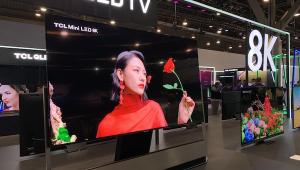8K Update: What’s Next for the Budding TV System? Page 2
Chinnock: It’s hard to predict, but we will need a decent installed base of 8K TVs, which could happen by 2024. Any major streaming service needs to see a value proposition in offering 8K so we need to show them that there is a visible difference between 2K, 4K, and 8K. They also need to know that the infrastructure for delivering 8K content at reasonable bandwidths is there and that consumers have the capacity to receive the content. Finally, streaming services need to start capturing content in ways that facilitate it being finished in 8K, which ties into another 8KA project for this year — writing guidelines for content capture to enable 8K mastering.

S&V: How big a role will gaming play in the adoption of 8K? And where do things stand today when it comes to 8K and the gaming community?
Chinnock: We think gaming will play an important role in the adoption of 8K. Many games are developed in very high resolution so they can then be authored in 4K or 8K versions. There will be visible differences between these versions, especially in the textures. Then there is game play where higher resolution is obtained through the graphics card (or TV) upscaling lower resolution games to 8K. Upscaled 4K will look better than 4K but not as good as native 8K.
While PlayStation 5 and Xbox X are supposed to support 8K output, they have not yet been upgraded to do so, which makes PC gaming with a high-end graphics card the best 8K gaming solution today. Then there’s the trend toward 4K/120 fps (frames per second), which sort of runs counter to the 8K trend. 4K/120 is more important for games where fast response is needed, like first-person shooter games. Running 8K at high frame rates taxes the best graphics cards, but here again, it is only a matter of time before the technology improves and brings this capability more downstream.
S&V: The best 4K content looks pretty amazing on a big screen. How does the transition from standard high-definition to 4K Ultra HD compare with what we’ll see when we move from 4K to 8K? What will get us most excited about 8K?
Chinnock: Simply adding more pixels on a mid-sized screen — say, between 50 and 65 inches — will offer diminishing returns, especially at long viewing distances. But as screen sizes get bigger — 75 inches and up — you will need 8K to maintain the same pixel density you get with 4K on smaller screens, so 8K will be most popular on these bigger screens. And when it’s well produced and properly delivered, compelling 8K HDR (high dynamic range) content will blow people away. I have received very positive feedback from viewers who have seen Olympic coverage in 8K at the Skirball Center, for example. The extra details and crispness of the image can make it feel almost three dimensional.

S&V: At the 2022 Winter Olympics some of the games are being broadcast in 8K in public spaces across China. Beyond that, I’m not aware of any plans for international 8K broadcasting, though NBC announced that the NBC Olympics VR by Xfinity app includes 150 hours of “immersive 8K coverage.” Anything you can share about 8K coverage of the Olympics?
Chinnock: I’ve reported about the public demonstrations you mentioned on our association website (8kassociation.com). One project called “Hundred Cities Thousand Screens” was created to install large outdoor screens of different sizes in various cities, allowing Olympic events to be shown in 8K, which is happening now. And, according to reports from China, the opening ceremony was broadcast live in 8K last Friday (February 4) in the Opera House at the National Centre for the Performing Arts in Beijing. The event was open to the public and an 8K image created with a 25,000 lumen 8K projector was displayed on an 800-inch screen along with a 5.1 audio track. The plans called for producing more than 90 hours of Olympics content for an 8K feed that is also being down-converted to 4K/HDR and 4K/SDR for broader distribution. You can check out my full report at 8kassociation.com for more details.
At the end of January, I reported that the Chinese government, along with its TV and telecom partners and institutions, was working on becoming the leader in 8K. They launched the Beijing Radio and Television’s Winter Olympics 8K Ultra HD Test Channel at the end of last year, a project that started in April 2021 and involved constructing an 8K production facility, producing 8K content, and developing an 8K app. Chinese officials said it was the first TV channel to provide 8K services to a broad audience in China and claimed the facility had produced more than 50 hours of 8K programs, encoded at 50 fps and with a 5.1 audio track. You can read my full report at 8kassociation.com.
S&V: What is being done to raise public awareness of 8K? Are there any events (sports or otherwise) on the horizon that will be used to showcase 8K technology?
Chinnock: We hope to have a booth in the Futures Zone at the 2022 NAB (National Association of Broadcasters) Show where we will have two demos. One will showcase the difference between the same content mastered in 8K vs. 4K. The other will showcase a live-in-the-cloud 8K implementation. I already mentioned some of the reports and guidelines the 8KA is planning to issue in 2022 and I’m sure we will attend and exhibit at other trade shows and continue to issue reports in our newsletter as well as conduct and participate in seminars and webinars.





























































